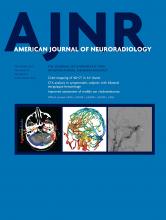Abstract
BACKGROUND AND PURPOSE: The Bayesian probabilistic method has shown promising results to offset noise-related variability in perfusion analysis. Using CTP, we aimed to find optimal Bayesian-estimated thresholds based on multiparametric voxel-level models to estimate the ischemic core in patients with acute ischemic stroke.
MATERIALS AND METHODS: Patients with anterior circulation acute ischemic stroke who had baseline CTP and achieved successful recanalization were included. In a subset of patients, multiparametric voxel-based models were constructed between Bayesian-processed CTP maps and follow-up MRIs to identify pretreatment CTP parameters that were predictive of infarction using robust logistic regression. Subsequently CTP-estimated ischemic core volumes from our Bayesian model were compared against routine clinical practice oscillation singular value decomposition–relative cerebral blood flow <30%, and the volumetric accuracy was assessed against final infarct volume.
RESULTS: In the constructed multivariate voxel-based model, 4 variables were identified as independent predictors of infarction: TTP, relative CBF, differential arterial tissue delay, and differential mean transit time. At an optimal cutoff point of 0.109, this model identified infarcted voxels with nearly 80% accuracy. The limits of agreement between CTP-estimated ischemic core and final infarct volume ranged from −25 to 27 mL for the Bayesian model, compared with −61 to 52 mL for oscillation singular value decomposition–relative CBF.
CONCLUSIONS: We established thresholds for the Bayesian model to estimate the ischemic core. The described multiparametric Bayesian-based model improved consistency in CTP estimation of the ischemic core compared with the methodology used in current clinical routine.
ABBREVIATIONS:
- AIS
- acute ischemic stroke
- ATD
- arterial tissue delay
- AUC
- area under the curve
- diff
- differential
- oSVD
- oscillation singular value decomposition
- rCBF
- relative CBF
- © 2019 by American Journal of Neuroradiology
Indicates open access to non-subscribers at www.ajnr.org







